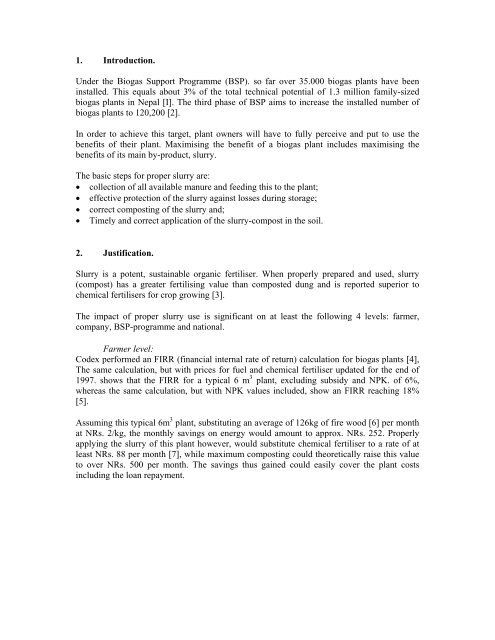download (pdf, 261kB) - SNV
download (pdf, 261kB) - SNV
download (pdf, 261kB) - SNV
You also want an ePaper? Increase the reach of your titles
YUMPU automatically turns print PDFs into web optimized ePapers that Google loves.
1. Introduction.<br />
Under the Biogas Support Programme (BSP). so far over 35.000 biogas plants have been<br />
installed. This equals about 3% of the total technical potential of 1.3 million family-sized<br />
biogas plants in Nepal [I]. The third phase of BSP aims to increase the installed number of<br />
biogas plants to 120,200 [2].<br />
In order to achieve this target, plant owners will have to fully perceive and put to use the<br />
benefits of their plant. Maximising the benefit of a biogas plant includes maximising the<br />
benefits of its main by-product, slurry.<br />
The basic steps for proper slurry are:<br />
• collection of all available manure and feeding this to the plant;<br />
• effective protection of the slurry against losses during storage;<br />
• correct composting of the slurry and;<br />
• Timely and correct application of the slurry-compost in the soil.<br />
2. Justification.<br />
Slurry is a potent, sustainable organic fertiliser. When properly prepared and used, slurry<br />
(compost) has a greater fertilising value than composted dung and is reported superior to<br />
chemical fertilisers for crop growing [3].<br />
The impact of proper slurry use is significant on at least the following 4 levels: farmer,<br />
company, BSP-programme and national.<br />
Farmer level:<br />
Codex performed an FIRR (financial internal rate of return) calculation for biogas plants [4],<br />
The same calculation, but with prices for fuel and chemical fertiliser updated for the end of<br />
1997. shows that the FIRR for a typical 6 m 3 plant, excluding subsidy and NPK. of 6%,<br />
whereas the same calculation, but with NPK values included, show an FIRR reaching 18%<br />
[5].<br />
Assuming this typical 6m 3 plant, substituting an average of 126kg of fire wood [6] per month<br />
at NRs. 2/kg, the monthly savings on energy would amount to approx. NRs. 252. Properly<br />
applying the slurry of this plant however, would substitute chemical fertiliser to a rate of at<br />
least NRs. 88 per month [7], while maximum composting could theoretically raise this value<br />
to over NRs. 500 per month. The savings thus gained could easily cover the plant costs<br />
including the loan repayment.
















